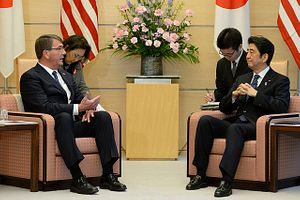Monday morning, Japan and the United States announced that they had finalized a set of updated guidelines for bilateral defense cooperation, concluding a process that began last year. The new guidelines (available here) take into consideration Japan’s revised defense posture, including the Abe government’s decision to reinterpret a constitutional provision to allow for Japanese participation in collective self-defense. The changes reflect Japan’s worries over China’s rise and enduring concerns over North Korea’s nuclear program.
The announcement comes on the first day of Japanese Prime Minister Shinzo Abe’s week-long visit to the United States; Abe will meet U.S. President Barack Obama tomorrow and become the first Japanese prime minister to address a joint session of the U.S. Congress on April 29.
According to Defense News, the new guidelines were agreed upon following a meeting in New York City in a “two-plus-two” format. Defense Secretary Ashton Carter and Secretary of State John Kerry represented the U.S. side while Defense Minister Gen Nakatani and Foreign Minister Fumio Kishida represented Japan. The updated guidelines will be the greatest change to U.S.-Japan defense cooperation in at least two decades, and will emphasize the “global” nature of the U.S.-Japan alliance. The guidelines will satisfy the Abe administration’s bid for Japan to pursue “proactive pacifism” in its security policy. For the Obama administration, updating the guidelines for defense cooperation with Japan is another notch on the long to-do list of its ongoing rebalance, or pivot, to Asia.
The new guidelines will also enable Japan’s broader participation in humanitarian and peacekeeping missions outside of its immediate region — previously, Japanese forces were restricted to deploying SDF assets in a regional designation, comprising the Korean peninsula, entitled “situations in areas surrounding Japan” (SIAS-J). Additionally, a few days after the United States announced a new cyber strategy, the U.S.-Japan guidelines will also set out parameters for bilateral cooperation in cyberspace, a first for the U.S.-Japan defense guidelines.
Organizationally, the new guidelines will help create an “alliance coordination mechanism” comprised of senior officials in defense and foreign relations in both countries (this was originally envisaged in the form a “bilateral coordination mechanism,” but never came into effect).
The terms of the finalized guidelines appear to mostly adhere to the interim report that the two countries released in December 2014. In that report, they emphasized five primary areas of focus for the revised guidelines, including “seamless, robust, flexible, and effective bilateral responses; the global nature of the Japan-U.S. Alliance; cooperation with other regional partners; synergy across the two governments’ national security policies; and a whole-of-government Alliance approach.” Though the guidelines could have likely been concluded late last year, they were delayed in part due to Abe’s decision to hold snap elections in December.
The new guidelines are comprehensive and address every aspect of the alliance and operational cooperation between the armed forces of both countries. Additionally, they outline the nature of cooperation between the U.S. and Japan in peacetime and wartime, detailing avenues of cooperation on intelligence, surveillance, and reconnaissance (ISR), air and missile defense, maritime security, asset protection, training and exercises, logistic support, and use of facilities. Similar to the older guidelines, the new document details how the U.S. and Japan would respond before, after, and during an attack against Japanese territory.
China, and other Asian countries, will be closely watching the evolution of the U.S.-Japan alliance, one of the long-standing geopolitical constants in East Asia.
The new defense guidelines are available here. The old U.S.-Japan guidelines can be found on the Japanese Foreign Ministry’s website here. The October 2014 interim report is available here.

































